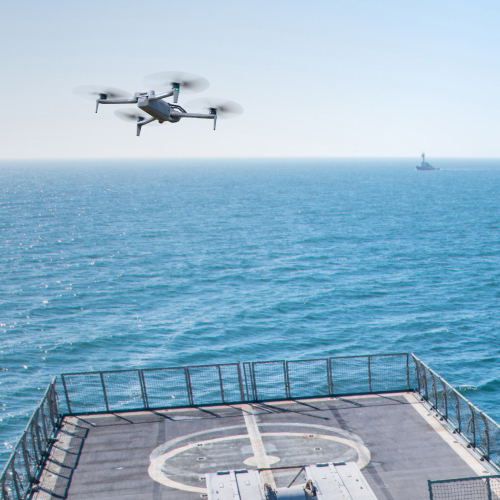
Unmanned aerial vehicles have played an important role in combat since the late 1960s, particularly in reconnaissance missions. Today, with the help of AI, small, autonomous drones such as Skydio’s sUAS platforms can leverage this reconnaissance capability to combat one of the most stubborn challenges to fleet readiness: corrosion. These smart drones can simplify the detection of this $7 billion dollar annual problem for the U.S. Navy, and also reduce the cost of controlling it.
A Smarter Approach to Predictive Maintenance
Corrosion can be mitigated to some extent, but it can never be eliminated. Furthermore, the rate of corrosion on any given ship on any given mission cannot be accurately predicted. This means that scheduled preventive maintenance often takes place either too early, which wastes money, or too late, which can put the structural integrity of a ship’s hull at risk, while giving ships an appearance not reflective of the United States as a world naval power.
In contrast, condition-based maintenance aligned to the most current condition of a hull ensures optimal timing for maintenance. This is where autonomous drones come into play. Visual data gives commanders and naval engineering teams a corrosion assessment in near-real time, so they can accurately determine the timing and the level of maintenance required for optimized maintenance operations.
The Value of Visual Data
Today, hull inspections are still often conducted by sailors on painter boards. This antiquated approach has three problems. First, it takes crew members away from their primary tasks at a time when many ships are already undermanned. Second, the results of personal observations are conveyed verbally or in written form, and words are limited. The level of detail and the potential urgency could be subject to misinterpretation, depending on the individuals providing and receiving the reports. Third, personal observation is a slow and tedious process.
The visual data drones provide is more precise than words, and is available in near-real time. This speed, convenient for inspections, is crucial during or after kinetic or dynamic events. The AI-powered platform can obtain immediate damage assessments. Detailed visual data can be forwarded to shipyards prior to the ship’s arrival, allowing for optimal planning, so resources are properly allocated, aligned and timed; reducing maintenance backlogs and getting ships back to sea faster.
AI-Powered Obstacle Avoidance
Manually flown small drones have a well-earned reputation for being difficult to fly. Skydio’s sUAS platforms use AI to deliver new consistency to flight operations, enabling safe, secure, repeatable and reproducible results in anyone’s hands. Software-defined obstacle avoidance simplifies and automates pilot operations while reducing training time for the operators to be proficient to fly their missions. More personnel can be trained faster, complex flying missions can be executed and critical infrastructure can be inspected safely and routinely. Other AI-powered features include automated workflows that produce textured models on the drone in just minutes, with no additional computers or systems needed – and no special training burdens. Machines should aid human team-mates, rather than adding unaccounted for burdens, and the right autonomous drones can do exactly that for ship commanders, sailors, and maintainers, ultimately changing the landscape of naval maintenance.
About Skydio
Founded in 2014, Skydio is the leading US manufacturer of autonomous drones utilizing breakthrough AI. Skydio designs, assembles, and supports its products in the US from its San Mateo, CA headquarters, offering the highest standards of supply chain and manufacturing security.
- Additive Manufacturing, Small Business Collaboration Highlight First Day of Sea-Air-Space 2024 - April 10, 2024
- Navies Face Future Fight in Undersea Defense - April 9, 2024
- AI-Powered Drones: A Revolutionary Solution to Navy Corrosion Challenges - November 7, 2023



